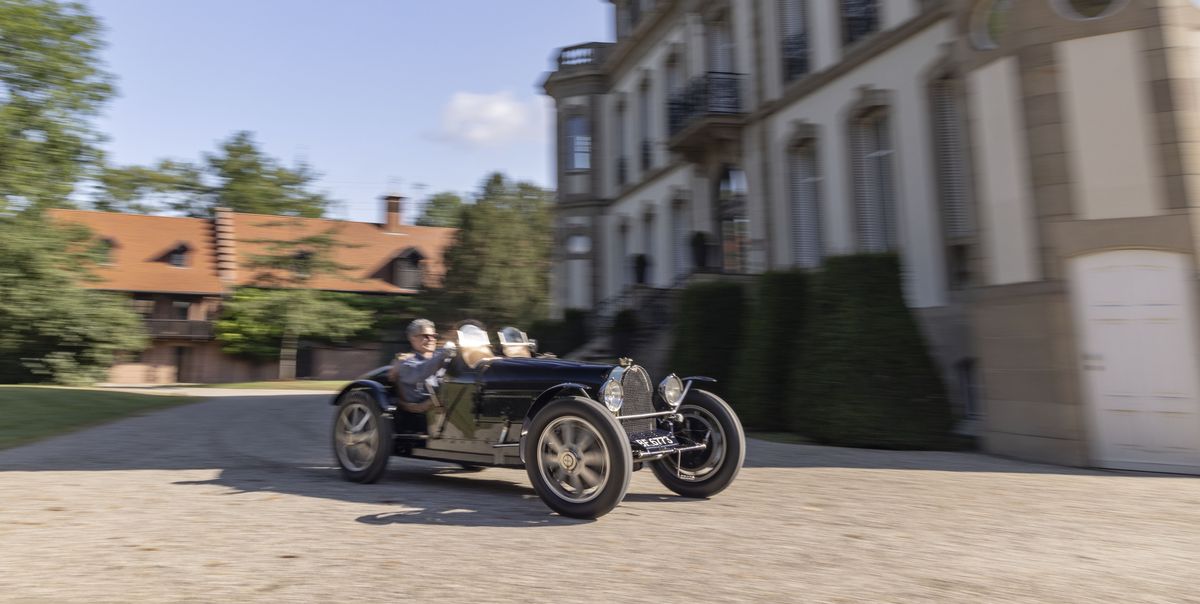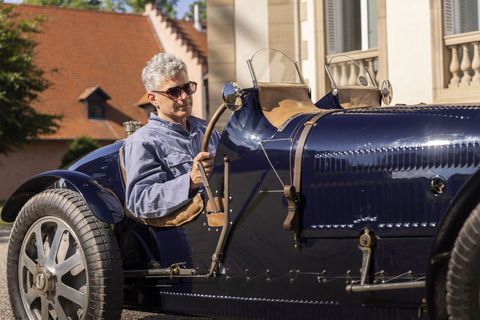Why the Bugatti Type 51 Is Weirdly Like a First-Gen Mazda RX-7

Michael ShafferCar and Driver
Starting the 90-year-old Bugatti Type 51 requires a complex procedure. First, you need to pressurize the fuel tank, using a pesticide-mister-style pump handle on the left edge of the engine-turned dash, just above the passenger’s left knee. Then you must open the fuel-feed line with a little lever and squirt some fuel into the engine with a round knurl-handled pump knob on the other edge of the dash. Then you need to open the hood to add some oil to the supercharger, presumably so it won’t burn itself up spinning as fast as it does. Then you close the hood and place the gated metal shifter—which is on the outside of the right-hand side of the car—into neutral. Then you press the starter, which sounds a bit like a silverware drawer the size of the Lusitania being maraca’d by the Greek god Polyphemus. You adjust the idle with another dial until the delicate white-faced Jaeger tach says the car is churning at around 700 rpm. Then the car stalls, and you have to repeat the process.
Did I mention this all takes place while wearing cosplay vintage-style light-blue Bugatti coveralls, elastic-cinched at the waist like an acid-washed denim leisure suit? Luckily, no leather helmets or silly goggles were required.

Michael ShafferCar and Driver

Michael ShafferCar and Driver
Fortunately, in dealing with this onerous process, this Bugatti—which is part of Bugatti’s own collection—comes equipped with Luigi Galli. He is the heritage and certification specialist for the pinnacle French/German/Italian brand and a human Wikipedia when it comes to vintage Molsheim whips. Impossibly young, Luigi is also impossibly patient.
The Type 51 was developed in the late 1920s as a successor to the Type 35, the winningest of Bugatti racing cars. Though it had a few significant updates to that adorable demon’s minuscule straight-eight engine—like a 2.3-liter displacement, a twin-cam design, and the aforementioned supercharger—which allowed it to produce what Luigi says is “well over 150 horsepower and drive at over 200 km/h” (124 mph), the state-sponsored teams from the rising fascist Axis powers in Germany and Italy trounced it on the track.
Still, it’s a proper race car. A fact that I discover after squeezing my rather narrow self into the extremely narrow driver’s seat and crowd my feet within the straw-width footwell. This area is worth describing, as the trio of metal pedals that occupy it look like they fell off some surrealist kinetic sculpture. The clutch resembles a tiny upright racing flag, the brake looks like a towering art deco champagne flute (albeit one with a screw in the dregs), and the gas is nothing more than two rolling wheels dangling from a long rod. Why? “The Bugattis were a family of artists,” Luigi says.

Michael ShafferCar and Driver
First gear is down to the left, like on my 1978 Porsche 928. But this ain’t no dogleg, dog. Second is directly above it. “That’s all you need to know,” Luigi says. Though this Type 51—originally owned by a Czech gentleman, followed by a life in Japan before repatriation to Alsace in 2002—is allegedly road legal, I am only going to be driving this six- or seven-figure relic around the grounds of the historic Bugatti Château, adjacent to which is the company’s atelier where it builds its Chirons and Centodiecis, and I don’t need to go too fast. (I do manage to sneak the car into third on the back straight, heading toward the gated security hut.)
![[composite mediaId='2701b463-bdb1-4bcf-a0ef-ea50e9a6b3ee'][/composite] bugatti type 51](https://insurancenewsmag.com/wp-content/uploads/2022/08/Why-the-Bugatti-Type-51-Is-Weirdly-Like-a-First-Gen.9995103182931095xh;center,top&resize=480:*.jpeg)
Michael ShafferCar and Driver
Direct, Honest, Unexpectedly Lithe
Despite the arcane startup procedure, the Type 51 feels improbably familiar. The wood-rimmed aluminum steering wheel is light and precise in its communication—perhaps the result of the bigger aluminum wheels and wider tires that were another upgrade from the Type 35. The shifter, despite its odd pattern, clicks through its detents precisely (discounting the requisite grinding, which Luigi shrugs off, nonplussed). The unassisted brakes require some thigh but do their job readily. And the engine pulls with throaty fervor, in part as a result of the car’s light 1600-pound weight. It reminds me, oddly, of a 1970s Japanese sports car—like an early Datsun 240Z or Mazda RX-7: direct, mechanical, honest, potent, precise, joyous, unexpectedly lithe. Not brutally fast, by today’s standards, but certainly quick.
My drive is rather short, but as I hit the kill switch and uncontort myself (and remove Luigi) in order to back out of the ribbed leather driver’s chair, I realize that this comparison isn’t that weird. The Type 51 was the F1 racer of its era, winning the Monaco Grand Prix, and was thus among the most sophisticated vehicles on the market. It was decades ahead of its time in technologies and capabilities, and thus able to leapfrog the space-time continuum and deliver a driving experience that would take the Japanese a generation of monomaniacal engineering to achieve.

Michael ShafferCar and Driver
This content is created and maintained by a third party, and imported onto this page to help users provide their email addresses. You may be able to find more information about this and similar content at piano.io



